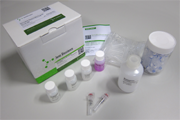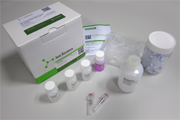SCRIPT One-Step RT-qPCR ProbesMaster lowROX, 10 x 1,25 ml (2x conc.)
Detailní popis
For in vitro use only!
Shipping: shipped on blue ice
Storage Conditions: store at -20 °C
avoid freeze/thaw cycles, store dark
stable at 4 °C for up to 4 weeks
Shelf Life: 12 months
Form: liquid
Concentration: 2x conc.
Description:
SCRIPT One-Step RT-qPCR ProbesMaster with highROX is designed for quantitative real-time analyses of RNA templates using Dual Labeled Fluorescent Probes. The ready-to-use mix is based on a genetically engineered reverse transcriptase with enhanced thermal stability providing increased specificity, high cDNA yield and improved efficiency for highly structured and long cDNA fragments.
The 2x conc. mix contains all reagents required for RT-qPCR (except template, primers and the dual labeled fluorescent probe) to ensure fast and easy preparation with a minimum of pipetting steps. The premium quality enzymes and the optimized reaction buffer containing ultrapure dNTPs ensure superior real time PCR results.
RT-qPCR is used to amplify double-stranded DNA from single-stranded RNA templates to allow a rapid real-time quantification of RNA targets. In the reverse transcription step the reverse transcriptase synthesizes single-stranded DNA molecules (cDNA) complementary to the RNA template. In the first cycle of the PCR step the hot-start DNA polymerase synthesizes DNA molecules complementary to the cDNA, thus generating a double-stranded DNA template. The hot-start polymerase activity is blocked at ambient temperature and switched on automatically at the onset of the initial denaturation. The thermal activation prevents the extension of non-specifically annealed primers and primer-dimer formations at low temperatures during PCR setup.
One-step RT-qPCR offers tremendous convenience when applied to analysis of targets from multiple samples of RNA and minimizes the risk of contaminations.
Content:
SCRIPT RT-qPCR ProbesMaster with highROX (red cap)
Ready-to-use mix of SCRIPT Reverse Transcriptase, Hot Start Polymerase, RNase Inhibitor, dNTPs, reaction buffer, ROX and stabilizers.
RNase-free Water (white cap)
Dual Labeled Fluorescent probes:
Real-time PCR technology based on dual labeled DNA probes provides a highly sensitive and specific PCR system with multiplexing capability. It requires two standard PCR primers and the DNA probe that hybridizes to an internal part of the amplicon. The sequence of the dual labeled DNA probe should avoid secondary structure and primer-dimer formation.
ROX reference dye:
The SCRIPT One-Step RT-qPCR ProbesMaster contains ROX passive reference dye. The dye does not take part in the PCR reaction but allows to normalize for non-PCR related signal variation and provides a baseline in multiplex reactions. The reaction chemistry of the kit is optimized for real-time cyclers that are compatible with the evaluation of the ROX reference signal.
Sensitivity:
Targets can generally be detected from <1 pg to 20 ng poly(A) RNA (mRNA) or 10 pg to 1 μg total RNA. Even lower amounts of RNA may be successfully amplified by using highly expressed transcripts.
RT-PCR assay without sample denaturation:
(standard RNA/primer combinations)
Preparation of the RT-qPCR Assay
[Please note: Sample denaturation is particularly recommended for RNA targets that exhibit a high degree of secondary structure, for self- or cross-complementary primers and for initial experiments with new targets. For many standard combinations of RNA and primers heat treatment may be omitted with no negative effect on results.]
Add the following components to a nuclease-free microtube. Pipett on ice and mix the components by pipetting gently up and down. In general, water, RNA and primers should be mixed together before the remaining components are added.
| com-ponent | stock conc. | final conc. | 20 μl assay |
50 μl assay |
| RNase-free water | - | - | fill up to 20 μl |
fill up to 50 μl |
| RNA template 1) | - | <100 ng | x μl | x μl |
| forward Primer | 10 μM | 400 nM | 0.8 μl | 2 μl |
| reverse Primer | 10 μM | 400 nM | 0.8 μl | 2 μl |
| dual-labeled Probe | 10 μM | 200 nM | 0.4 μl | 1 μl |
| SCRIPT RT-qPCR Probes-Master with highROX 2) | 2x | 1x | 10 μl | 25 μl |
1) up to 100 ng polyA RNA or total RNA
2) SCRIPT RT-qPCR Probes-Master with highROX already contains RNase inhibitor that may be essential when working with low amounts of starting RNA.
Continue with reverse transcription and thermal cycling as recommended.
RT-PCR assay with sample denaturation:
(RNA/primer with a high degree of secondary structure)
[Please note: Sample denaturation is particularly recommended for RNA targets that exhibit a high degree of secondary structure, for self- or cross-complementary primers and for initial experiments with new targets. For many standard combinations of RNA and primers heat treatment may be omitted with no negative effect on results.]
Preparation of the RNA Template / Primer Mix
Add the following components to a nuclease-free microtube and mix by pipetting gently up and down.
| com-ponent | stock conc. | final conc. | 20 μl assay |
50 μl assay |
| RNase-free water | - | - | fill up to 10 μl |
fill up to 25 μl |
| RNA template 1) | - | <100 ng | x μl | x μl |
| forward Primer | 10 μM | 400 nM | 0.8 μl | 2 μl |
| reverse Primer | 10 μM | 400 nM | 0.8 μl | 2 μl |
| dual-labeled Probe | 10 μM | 200 nM | 0.4 μl | 1 μl |
1) up to 100 ng polyA RNA or total RNA
Denaturation and primer annealing
Incubate the mixture at 70 °C for 5 min and place it at room temperature for 5 min.
Complete RT-qPCR Mix
Add SCRIPT RT-qPCR ProbesMaster with highROX to the RNA/Primer Mix according to the table below. Pipett on ice and mix by pipetting gently up and down.
| com-ponent | stock conc. | final conc. | 20 μl assay |
50 μl assay |
| SCRIPT RT-qPCR Probes-Master with highROX 2) | 2x | 1x | 10 μl | 25 μl |
2) SCRIPT RT-qPCR ProbesMaster with highROX already contains RNase inhibitor that may be essential when working with low amounts of starting RNA.
Reverse transcription and thermal cycling:
Place the vials in a PCR cycler and start the following program.
| reverse transcription 3) |
50°C | 10-15 min | 1x |
| initial denaturation 4) |
95°C | 5 min | 1x |
| denaturation | 95°C | 15 sec | 35-45x |
| annealing and elongation |
60-65°C 5) | 1 min 6) | 35-45x |
3) A reverse transcription time of 10 min is recommended for optimal amplicon lengths between 100 and 200 bp. Longer amplicons up to 500 bp may require a prolonged incubation of 15 min. Add 3 min for each additional 100 bp. The optimal temperature depends on the structural features of the RNA. Increase the temperature to 55°C for difficult templates with high secondary structure. Note that optimal reaction time and temperature should be adjusted for each particular RNA.
4) An initial denaturation time of 5 min is recommended to inactivate the reverse transcriptase.
5) The annealing temperature depends on the melting temperature of the primers and DNA probe used.
6) The elongation time depends on the length of the amplicon. A time of 1 min for a fragment of 1,000 bp is recommended.
For optimal specificity and amplification an individual optimization of the recommended parameters may be necessary. Note that optimal reaction times and temperatures should be adjusted for each particular RNA / primer pair.
Hodnocení produktu
Produkt zatím nikdo nehodnotil, buďte první!


